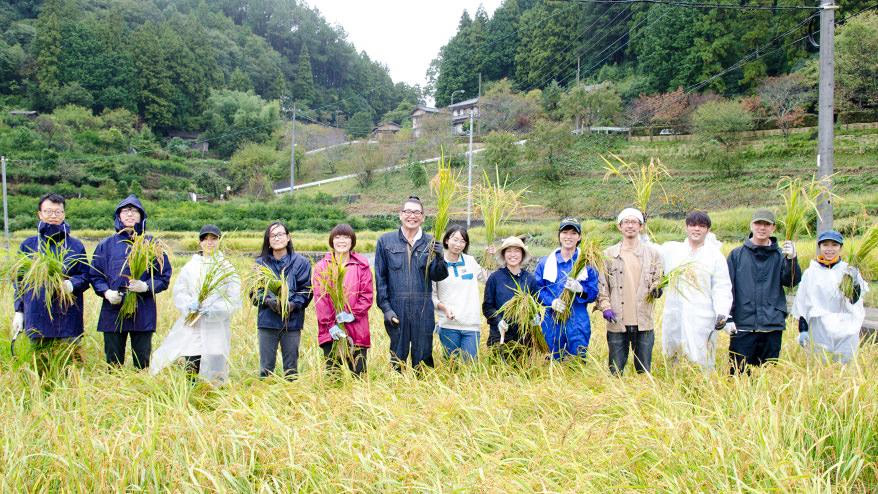Hello. This is Omura from the editorial department.
The rice was planted in June in Kamiyama Town, Tokushima Prefecture, where our satellite office is located, and was successfully harvested in late October.
The experiment by Food Hub Project 's (Food Hub) agricultural director, Kaoru Shirato, who has been keeping an eye on the rice fields, was a great success, and the rice was produced without any pesticides, which we all enjoyed at Monosus' 13th anniversary party the other day. The 2017 Monosus rice allowed us to learn about the entire process, from planting the seedlings to eating it.
Today I will tell you about what happened after planting the rice, and how the harvest went, which took place in light rain as a typhoon approached.
After the rice planting
After finishing planting in June, I wondered when Hakuto would contact me to tell me that weeding was necessary... This summer, I was a little nervous every time I thought of Monosasu Rice's rice field in between work. However, I never heard from Hakuto that weeding was necessary... Weeding the rice field, which I helped out only once during the Monosasu Juku last year, is quite a difficult task and requires many people. I couldn't go there from Yoyogi right away, so I was worried about how to secure the manpower when weeding was necessary.
As I wrote in my previous article , I had heard that using rice bran compost containing horseshoe crabs and EM bacteria makes the rice paddy environment less conducive to weed growth, but I still thought that mowing the grass was necessary.
Meanwhile, at the end of August, Hakuto contacted us to tell us that the rice had ears and was growing well.

The state of the rice at the end of August.
The rice has grown! Green ears of rice against the blue sky. I am impressed that the seedlings have borne fruit.
We also received a message saying, "We need to decide how we will grow rice from now on." We will decide whether or not to mow the grass (weeding) depending on the situation of the choice we make from now on.
We had to make two decisions:
1) Whether or not to spray pesticides
2) How to harvest rice
First, regarding the spraying of pesticides, there have been reports of stink bugs sucking the grains of rice that have begun to ripen. It turns out that the "black rice" is being produced by these stink bugs sucking the grains.

However, even if the rice turns black, there is no problem with eating it. Indeed, I have seen black rice mixed in occasionally, but I never thought that stink bugs were consuming it. The only way to prevent this is to spray pesticides, but Food Hub does not spray pesticides unless there is an abnormal occurrence. We followed that policy and chose not to spray pesticides.
Next, "How should we harvest the rice?" There are three methods.
- Harvested by hand and dried in the sun (about 6 hours in total)
- Harvested by machine and dried in the sun (about 5 hours in total)
- Machine harvesting and machine drying (30 minutes)
If you decide to mow the grass mechanically, you will need to mow the grass beforehand, but if you mow the grass by hand, mowing will be unnecessary.
After discussing with the Monosasushi Rice Committee, we decided that we wanted to grow rice as pesticide-free as possible, that we wanted to experience the process of making rice without using machines, and that we wanted to dry rice in the sun because we had heard that sun-dried rice is completely different. Therefore, we decided on "no pesticide spraying" and "hand-harvesting without weeding and drying in the sun."
It's finally time to harvest rice
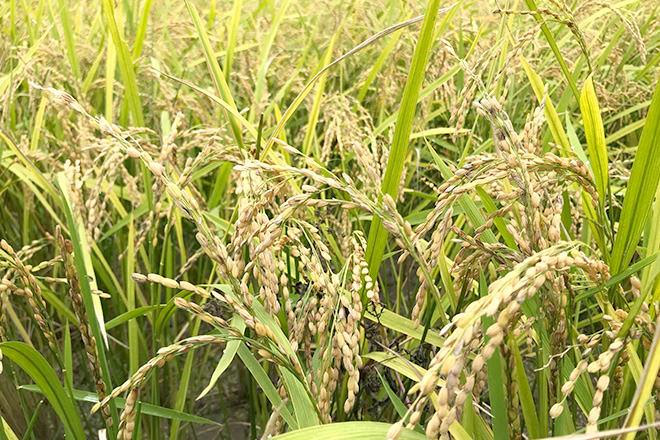
This is rice from early October. It's ripe and ripe!
We are already halfway through October and it is finally time to harvest the rice.
However, during this time of year, both Tokyo and Kamiyama experienced continuous drizzle rain for several days...
The weather forecast for the week of the planned rice harvest showed only light rain in the morning of the day, followed by rain the day before. The forecast also said that a large typhoon would arrive the following day.
In this situation, it may be best to wait for a sunny day and then cut and dry the rice by machine, but the continuous rain has caused the rice grains to sprout, and if we wait for a sunny day, the sprouts will continue to appear. Also, in the rain, the machine gets clogged, so it is not possible to cut the rice by machine.
I consulted with Shiramomo until the very morning of the day, and as we had a feeling that we could somehow make it happen in between the rain, we decided to go ahead and say, "Let's do it!"
This is the first time for them to harvest rice in the rain. Thank you very much...
And on the day of the event, about 15 people gathered in the rain, including 10 members of the third batch of Kamiyama Monosasu Juku, the school's principal, Ito, members from Yoyogi, and members from the satellite office. They prepared their raincoats and started harvesting the rice.
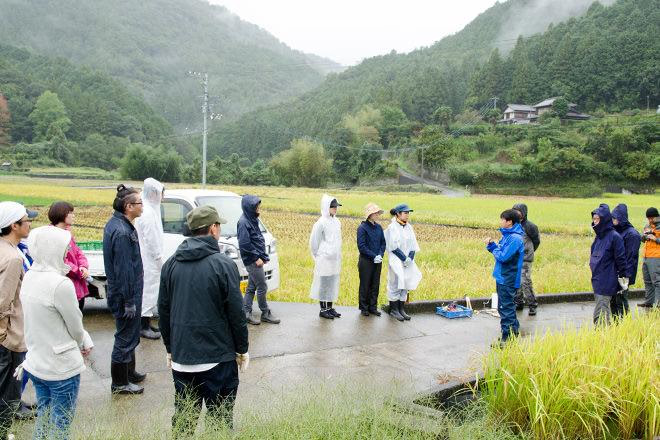
Shiramomo-san sent us photos, and it really makes us happy to see the golden ripe rice in the rice fields.
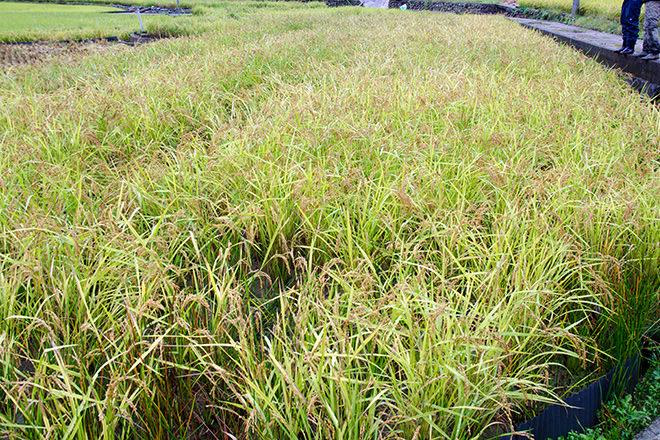
Because they were planted by hand, there are gaps here and there and they are not lined up neatly, but the field is covered with rice ears!
This time, we will be receiving guidance from agricultural director Shiramomo and farm manager Watanabe Hirotaka.
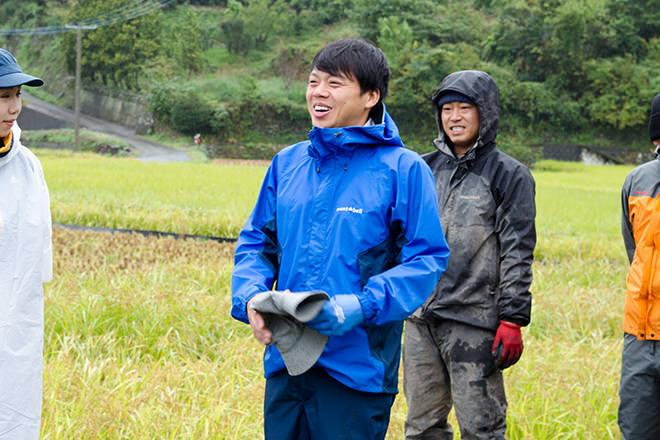
Agricultural manager Shiramomo (foreground) and farm manager Watanabe Hirotaka (back)
When harvesting rice, we grab as many rice plants as possible into bundles, grab them by the base, and cut them with a sickle.
The students are from the rice-producing region of Niigata, some of them bought overalls as soon as they came to Kamiyama, and many of them have experience helping with the rice harvest in September, so it's a great start...

Everyone is used to doing it.
The cut grass is tied in a bundle at the back and then moved forward.
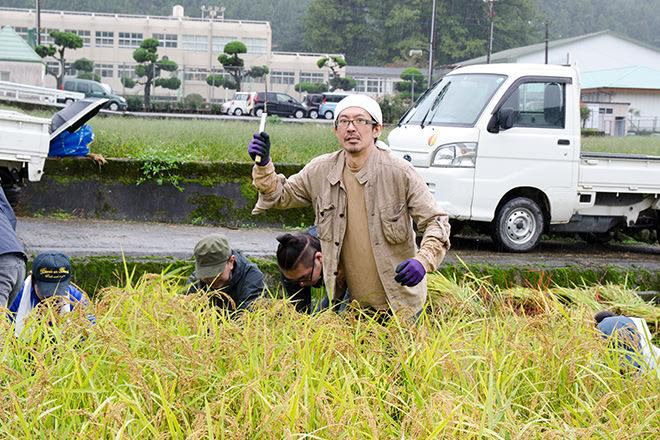
For some people, carrying a sickle can be a bit dangerous...

Everyone continued working in silence, but along the way, someone reported finding mushrooms!
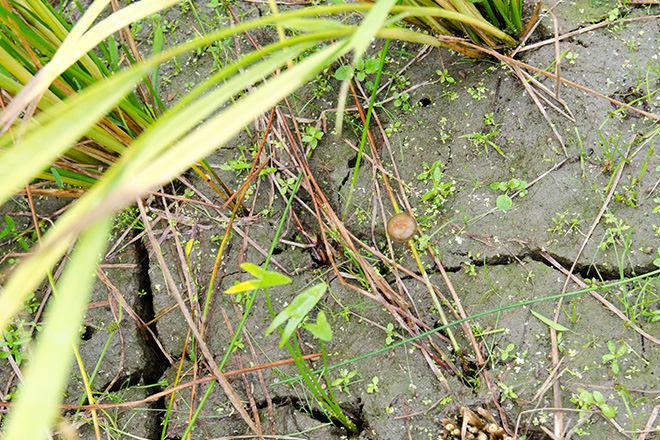
The brown round thing is a mushroom
As you can see from looking at the ground, there aren't many weeds growing. Even though there were some here and there, it wasn't hard to tell whether they were rice or grass, and I was able to firmly grasp the rice and cut it.
Some members simply cut the grass without thinking, while others listened to music in one ear and worked silently, cherishing momentum. Some worked while singing along with Headmaster Ito, who began singing a frog song. It was tough work, as we had to squat down on muddy ground and sometimes got stuck. I had to stretch my back several times to continue, but each member found their own way (and showed their individuality?) to cut the grass.

On the left, the members are working silently and at an amazing speed. On the right, the members are cutting with vigor and force. We were worried about the cold, but everyone worked hard, dripping with sweat.

As we were singing a song about frogs, a frog really did appear!
Once a certain amount of the grass has been cut, it is gathered together on the side of the rice field, tapped to even out the bottom, and tied with string near the base.
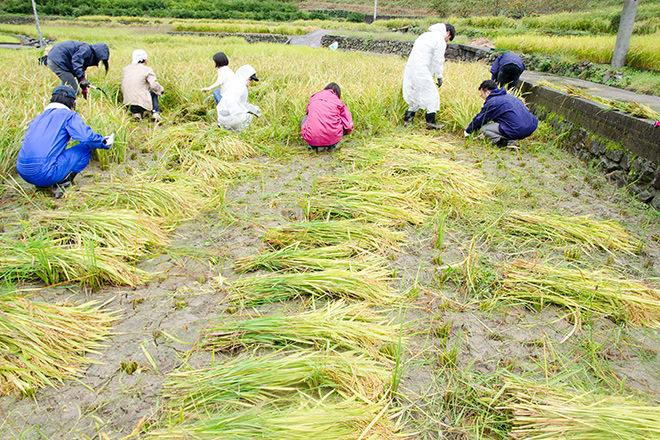

After cutting, it's time to tie up the grass. The third-year students of Monosasu Juku look great in their overalls.
And finally, we finished mowing!
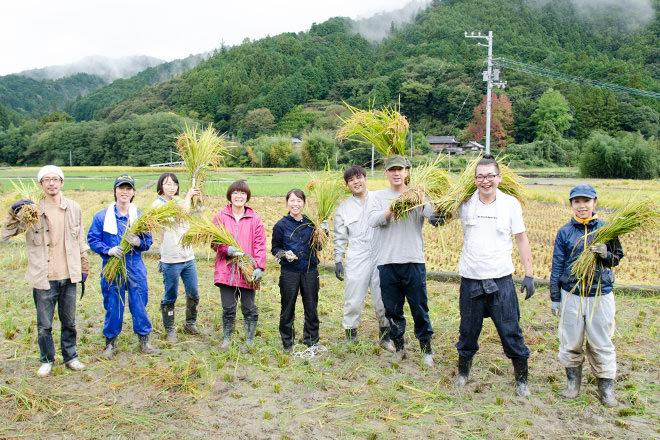
All the third-year students. What beautiful smiles!
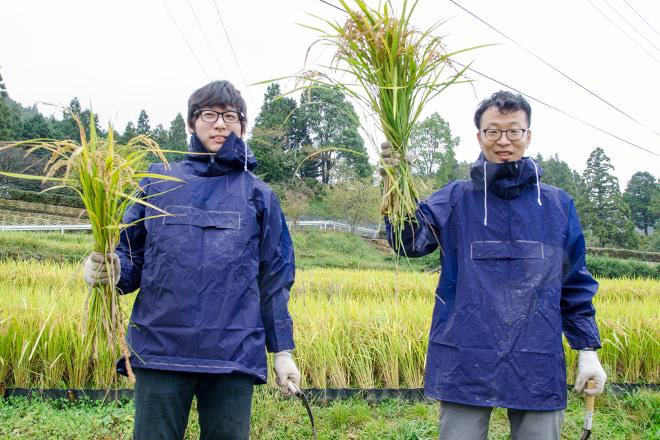
Members of Yoyogi and the satellite office are usually concentrating on their computers. They haven't harvested rice since they were in elementary school.
I really wanted to dry them out in the sun here, but unfortunately there is a typhoon starting tomorrow. If I dry them out here, they will be blown away by the typhoon, so I decided to dry them out in a vinyl greenhouse.
Load it onto a light truck for transportation.
It took about an hour and a half to get this far. Thank you for your hard work, even in the rain.
The rice ears filled two light truckloads.

Then we went to the greenhouse. The third-year male members stayed behind to continue the work.
The fish are hung in a greenhouse, and then divided into two parts, starting from the tied part, and hung to dry on a bar.
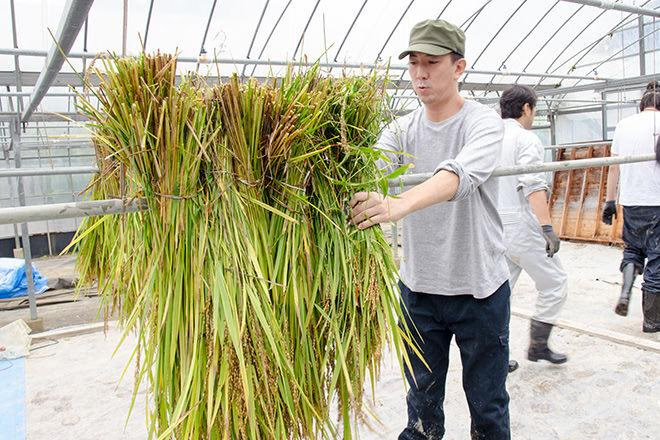
It was a huge amount of rice that filled two light trucks. We carried it from the light trucks to the greenhouses by bucket relay. They called out to each other and played as a well-coordinated team!
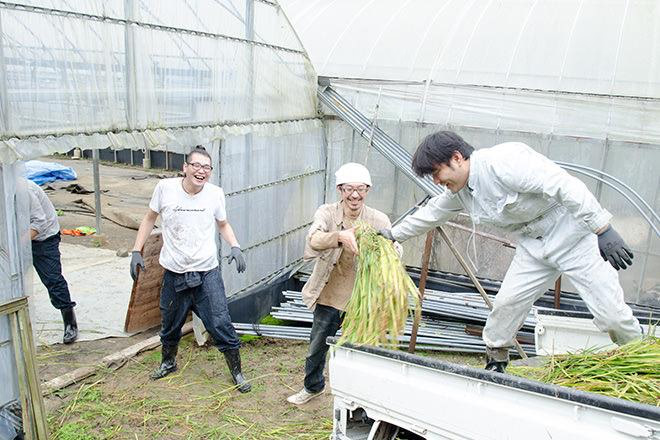
It was a time when we got a glimpse of the good teamwork among the third-year students.
Hang everything out and wait until it is completely dry.

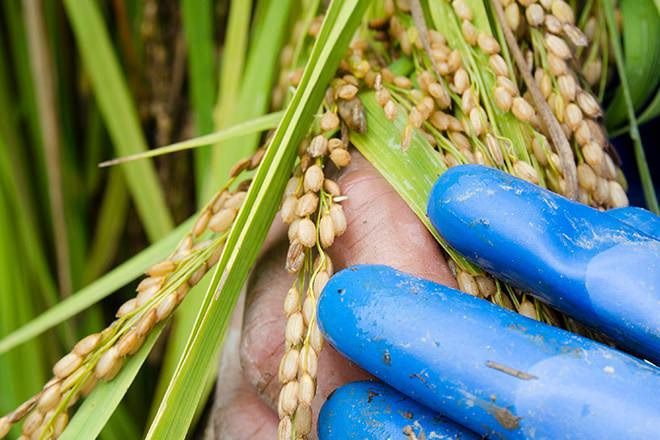
White sprouts were emerging from the ears of rice.
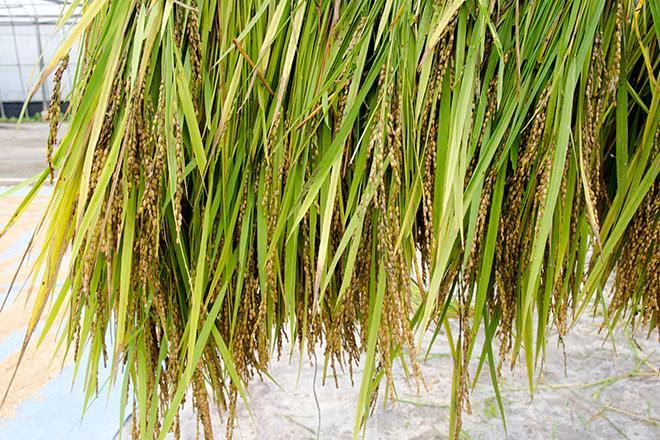
The water keeps dripping down
It would take several days for the rice to dry completely, so we left it to Shiramomo to finish harvesting.
The rice is done!
At the beginning of November, Hakuto reported to us that the rice was ready!

It's thoroughly dry.
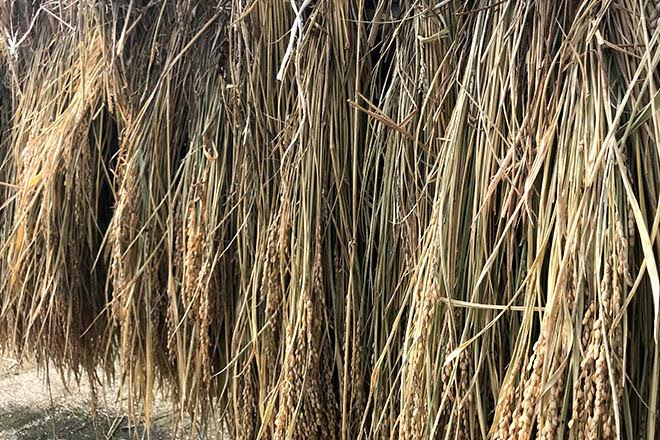
With the humidity in the greenhouse adjusted, it took nearly 10 days for the plants to finally dry.
Please put it through the thresher...
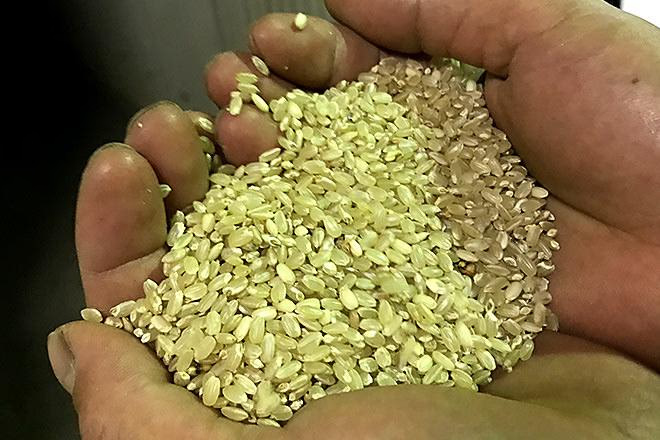
Freshly threshed rice!
It became rice!!
Those ears of rice become this rice...
It is indeed quite moving.
The harvest yield was 50kg. This year, there was no rain during the planting season, which delayed the timing of planting, and then rain continued to fall during the harvest season. When planting by hand, the seedlings in the area that grows best (the area farthest from the water inlet. Apparently this is where the water warms and the rice grows best) were not planted properly, leaving gaps, so the harvest yield was about 60% of the usual amount. I'll learn more about hand planting next time...
This year has been a tough year for growing rice, but the rice grew well in such a harsh environment. I'm curious to know what it tastes like!
This year, Monosus' anniversary party will be held at Kamaya, a restaurant in the Food Hub, so the unveiling will be held there.

This year's party is called "The Harvest Festival of Ruler Freedom." We all decided to make rice balls and eat them together.
The rice is cooked over an open flame instead of gas in the stove at the restaurant.
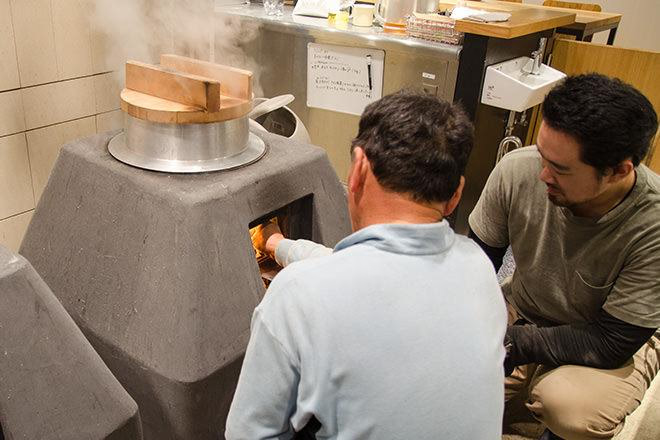
Mr. Shigeru Shiramomo (left), the father of the farm director, and agricultural guidance officer, and Mr. Sasagawa, the baker of Kamapan, light the fire in the hearth.
The resulting shiny rice balls had a gentle flavor and crumbled easily inside the mouth.
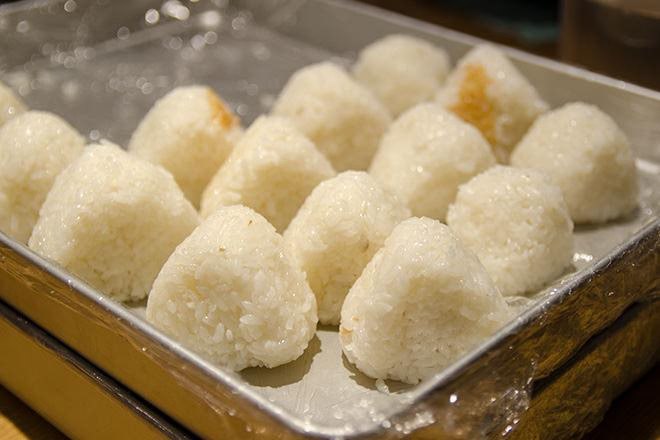
Then, Kamaya's head chef, Mr. Hosoi, prepared a spectacular paella in the middle of the party venue!!
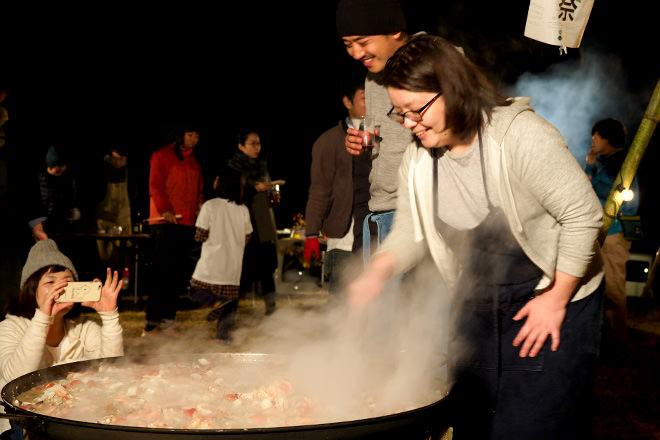
It was full of fresh shrimp, squid, and other seafood, as well as cherry tomatoes. Everyone mixed it together and made a lively dish that was perfect for the harvest festival.
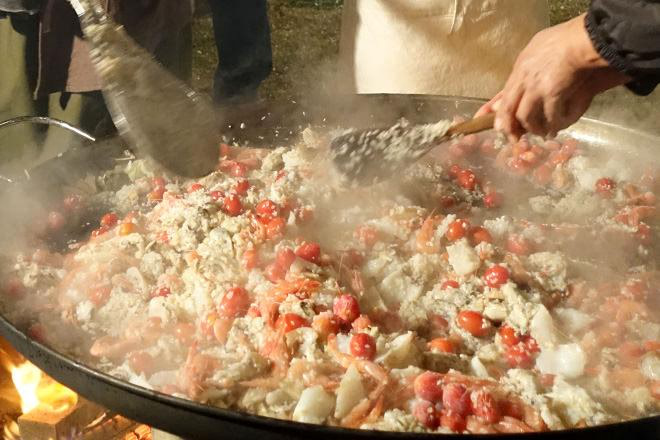
I will never forget that everyone who tried it was saying "It's delicious!" in various places.
It seems that the whole body reacts to something that is truly safe and delicious.
This year's rice would not have ripened without the daily care of the farm manager, Mr. Shirato, but for me, this autumn was also one in which I was able to feel the joy of harvesting. I was impressed by Mr. Shirato's comment that "We depend on the weather, but that's also what makes farming interesting."
My grandmother used to tell me long ago that "There are seven gods in one grain of rice," but I learned that it really does take a lot of time and effort and a variety of judgments to grow rice, such as maintaining the amount of water and making sure no weeds grow over the six months from planting the seedlings to when it is ready. I would like to be able to imagine more about the people and processes that are involved in the production of not only rice, but also other crops.
If I were to grow Sasu rice again next year, the weather would surely be different, so the way it grows would be different. There is only so much I can do, but I would like to make use of what I learned this year (planting seedlings properly!)!
